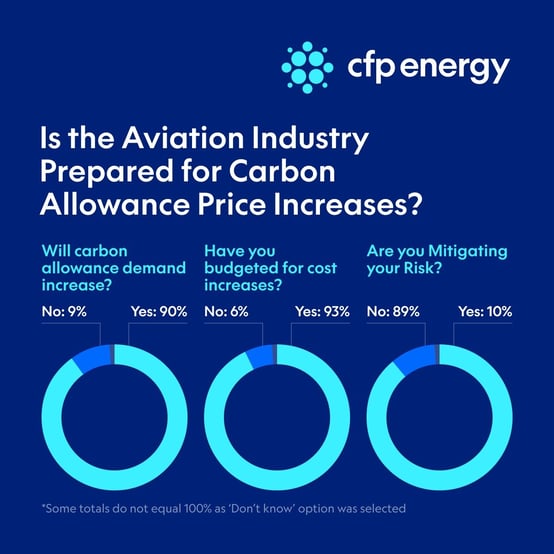In 2022, the UK’s domestic and international flights produced 29.6 million tonnes of CO2 equivalent emissions. Totalling around 7% of total UK greenhouse gases (GHGs), this highlights the need to address aviation emissions and their environmental effects.
At CFP Energy, we lead the way in aviation decarbonisation, energy transition services and risk management. From ETS and CORSIA to feedstocks and SAF Credits, we provide expert advice and advanced market access to a range of products to help you navigate the aviation sector's regulations and abate your emissions.
Contact our team of aviation specialists to discuss your options today.
What Are Aviation Carbon Emissions?
Aviation carbon emissions are primarily generated from the combustion of jet fuel. Usually composed of kerosene, jet fuel is a fossil-derived hydrocarbon that produces substantial amounts of CO₂ and other greenhouse gases when burned.
One way to reduce aviation emissions is through electrification. However, due to inherent limitations in current aircrafts, this can be hard to achieve in practice - the amount of weight airliners must carry (i.e., passengers and cargo) means there is often little capacity to carry the extra load of electric batteries, which at present can often weigh as much as p to 1,500 tonnes to match the typical energy output of jet fuel.
Innovative biofuels like Sustainable Aviation Fuel (SAF) and offsetting schemes like CORSIA, however, now provide a viable alternative. Through these innovative solutions, airlines can now abate their CO₂ emissions without having to carry extra loads or alter their aircraft's design.
Aviation's Climate Impact
According to the ICAO (International Civil Aviation Organisation), the aviation sector is growing fast, with current estimates suggesting that demand for air transport will increase by an average of 4.3% per annum over the next 20 years.
While this is still only a small fraction of the absolute emissions in other sectors, such as road transport, because aviation is hard to electrify, the sector must adopt other long-term decarbonisation strategies.
Part of this process involves acknowledging that aircraft can produce a range of effects besides jet fuel emissions that contribute to global warming - from contrails and NOx to water vapour and aerosols.
Beyond Standard Emissions: How Aviation Affects the Climate
Water vapour and contrails: As a byproduct of jet fuel combustion, aircraft engines produce water vapor. At high altitudes where temperatures are extremely cold, this vapor can form visible trails of condensation (contrails). Under certain atmospheric conditions, these contrails can persist and spread into clouds that trap heat from the earth's surface, creating a warming effect similar to that of natural cirrus clouds.
Nitrogen oxides (NOx): In addition to CO₂ aircraft engines emit nitrogen oxides at cruise altitude, leading to distinct effects than at ground level. In the upper troposphere, NOx can form ozone, which, at this altitude, acts as a greenhouse gas. NOx can also contribute to atmospheric methane, which has similar adverse effects.
Particulates and aerosols: Alongside NOx and CO₂, aircraft emit soot particles and other aerosols that can affect cloud formation. These particles can act as condensation triggers, potentially altering natural cloud patterns and their radiative properties.

Pathways Towards Sustainable Aviation Carbon Emissions
Aviation still suffers from key setbacks when it comes to achieving full sustainability, not least of all the difficulty of upgrading existing aircraft designs. But there are still many strategies available to reduce the air travel carbon footprint.
Developing and increasing the use of Sustainable Aviation Fuels (SAF)
Sustainable Aviation Fuel provides an alternative to fossil fuels used in standard jet fuel. With reduced CO₂ exhaust properties, the ability to blend the biofuel with ordinary jet fuel, SAF and SAF credits provide a sustainable means of powering aircraft without having to overhaul existing aircraft designs. Under the UK’s SAF Mandate, biofuels should provide 10% of aviation fuel for flights within and departing the UK by 2030
Improving efficiency through better operations and flight path optimisation
Operational efficiency, such as flight path optimisation, is one way in which the aviation sector can help drive down emissions. By using cutting-edge technologies, like Artificial Intelligence (AI) and Machine Learning (ML), airports can now coordinate flights using the most optimal routes, factoring in weather conditions, terrain, and Extended-Range Twin-Engine Operational Performance Standards (ETOPS) ratings.
Researching and developing future low/zero-emission aircraft propulsion
Cutting-edge research and development is another way that the aviation sector can decarbonise. Hydrogen fuel cells, currently under development by companies like Airbus, promise a future in which aircraft will one day be powered by hydrogen rather than fossil fuel. Meanwhile, Open Fan and Ultra-High Bypass Engine technologies aim to significantly reduce fuel emissions by improving fuel efficiency.
CFP Energy - Reducing Aviation Emissions for a Sustainable Future
At CFP Energy, we can help you instantly reduce your air travel carbon footprint.
From SAF and SAF credits to CORSIA and EU/UK ETS and ETS2 compliance, we supply a range of products and services to help you address aviation carbon emissions. To see how we can accelerate your transition to cleaner fuels, contact our carbon team today.